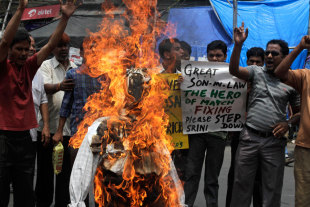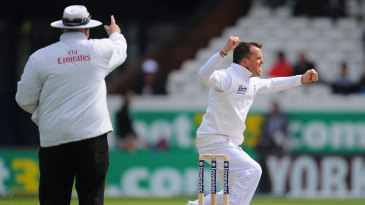No dirges for Test cricket, and the importance of Misbah

In October last year I went to watch Pakistan play South Africa in Dubai. Never in my life have I walked into a cricket ground on the first day, or any day, of a Test match in an atmosphere so desolate. The air was still, and even the trees looked lifeless. The security staff didn't seem to care either. No metal detector, no checking of bags, not even a cursory glance at my ID. Inside the vast but sparsely populated press box, Andy Zaltzman, author of the Confectionery Stall, and Statsguru devotee, pronounced with triumphant certainty that it was the first cricket match where the number of Jews in attendance outnumbered the spectators in the stands.
Zaltzman, who had stopped over in Dubai to watch the Test, was the only Jew. Outside the press box, and barring players, umpires, officials and security men, the ground was literally and metaphorically soulless.
As play began and Dale Steyn charged in with the new ball I wondered how he felt running in in front of empty seats, or how the barrenness behind the sightscreen looked to the batsman as he looked up from his meditative pause after taking guard.
This was perhaps an extreme case - it was a working day, and most people in Dubai who might be interested in cricket don't live there for recreation but to make a living - but certainly not an isolated one. Tests were played to near-vacant stands in New Zealand, in Zimbabwe, in Sri Lanka, and in the West Indies throughout the year. In Harare only a handful watched Zimbabwe pull off the rarest of Test wins against Pakistan; in Dunedin only a few more saw Darren Bravo bat for nearly nine hours after West Indies had followed on; and in Galle, Bangladesh marched to their record-breaking total before a few hundred fans.
Through the course of 2013 I also watched Tests at The Oval, the Wankhede Stadium and the Gabba, and each ground pulsated with energy and emotion. There was a hum and buzz on the way to the ground, long queues, thorough frisking at the gates, and noise and colour in the stands. But then these Tests had two of cricket's biggest draw-cards: the Ashes and Sachin Tendulkar.
On the face of it, this was cricket's great divide, between palpable passion and stark indifference, between cricket's elites and the teams that increasingly get pushed to the margins with each passing year.
But the truth about Test cricket might be located somewhere in between. Attendance, or lack of it, at cricket grounds can no longer be considered an accurate measure of support. In most parts of the developing world, going to a cricket ground is, in fact, a luxury. Fans engage with Test cricket in different ways.
We at ESPNcricinfo know it because Test matches remain our biggest draw outside of World Cups. Not only do fans follow scores avidly on computer screens, tablets and mobile phones, they also read our match reports and analyses, and comment on and discuss them. Match Point, our newly minted live analysis show during India's Test engagements with West Indies and South Africa, easily became our most-watched video programme from its very first day, and the numbers have kept multiplying. Almost every cricket fan I know watches Test matches on TV - not in their entirety but enough to keep pace with the plot and narrative. And for broadcasters in most part of the world, Test cricket is a relatively cost-effective way to fill airtime with fairly high-quality programming.
But the bigger truth lies on the field. As the morning session wore on in Dubai, I ventured out of the press box to take one of the vacant seats in the stands. Steyn had taken a wicket off the second ball, and Imran Tahir, brought on to bowl before lunch, seemed to be taking one every over. The noise of bat and ball was resounding, you could hear players talk, and they could hear you clap. Suddenly it seemed a purer, more authentic and more intimate experience. The players seemed to be in a bubble of their own, oblivious to the emptiness around them, and consumed by the contest.
That cricketers care matters. In his lecture to kick off ESPNcricinfo's 20-year celebrations, Rahul Dravid described Test cricket as the game's life source, the trunk of the tree that bears the branches carrying the fruits. But Dravid's act is over; what if those who follow him didn't bother?
Evidence was forthcoming from India's young batsmen on the tour to South Africa. India have lost nine of their last ten overseas Tests, and once again, the thinness of their bowling stood pitilessly exposed, but in the eyes of their young batsmen was hunger and desire for Test cricket. These men are millionaires and poster boys already, and their bank balances and stardom will stay intact if they only maintain their ability to belt the ball on flat pitches. In comparison, Test cricket is hard work for much less.
But how hard they fought. Of Virat Kohli and Cheteshwar Pujara it was expected. But Murali Vijay batted 375 balls, Ajinkya Rahane 442, and though the tour was a failure for him, Shikhar Dhawan, who scored 187 off 174 balls in his debut Test innings, battled for two hours in the final innings in Durban, scoring only 19 from 87 balls. Overall, a top order with a combined experience of 59 Tests had batted an average of 105 overs per innings in the series, which beat the average of their far more illustrious predecessors on recent tours to England and Australia by nearly 30 overs.
India holds the key to the future of cricket, and in their doggedness and resolve, and their stomach for the grind of Test cricket, the new generation of Indian batsmen have made a statement of reaffirmation.
****

But cricket's future won't be safeguarded on the playing fields alone. Boardrooms will play a bigger role, and foresight and vision haven't been traditional virtues of cricket's administrators. Later this month, the ICC's Finance and Commercial Affairs Committee is expected to submit to the ICC board a set of proposals with far-reaching ramifications.
It is futile to second-guess the proposals, but from the news that has filtered out, they will focus on scheduling, striking a balance between the three forms of the game, and on the distribution of the ICC's central pool of revenue. The committee is chaired by Giles Clarke, the chairman of the ECB, and among its members are Alan Isaac, the ICC president; N Srinivasan, the BCCI president; Wally Edwards, the chairman of Cricket Australia; and Dave Richardson, the ICC CEO. If anything, it can't be accused of lacking heft.
The question therefore is whether their collective will and wisdom can rise above the narrow self-interest that has guided decision-making in cricket administration in recent years. There is no doubt that the cricket calendar needs fixing, that some Test-playing countries do not pull their weight, and that there is little monitoring of the use of the funds distributed by the ICC to its members.
A feeling has persisted among Indian administrators that the BCCI's clout in cricket's power structure is resented by boards that have lost their influence. That's not unlikely because grace from the disfranchised isn't common. But the time to worry about it is long gone. The BCCI's sway over cricket affairs is unquestioned, and the world, however grudgingly, recognises and bows to its pre-eminence. It is down to the BCCI what it makes of its position.
There is a case that the hand that feeds the world must look after itself. So reliant is cricket's financial ecosystem on Indian money, which in turn relies on the devotion of millions of Indian fans, that it is in the interest of world cricket to keep the Indian fan happy. So yes, India must carve out its own home season; it must invest in finding talent. There can even be a case made that given the size of its player base and the fact that it generates most of the ICC's money, it has a bigger claim on those revenues than relatively smaller countries like England and Australia.
But it also falls on the leader to demonstrate a concern for the well-being of the game, a spirit of generosity and accommodation, and a long-term vision. It was disappointing that the BCCI let its petulance, however legitimate, over Haroon Lorgat being appointed CEO of Cricket South Africa, restrict India's tour of South Africa to two Tests. Lorgat's record as the ICC's chief executive was chequered, but fans care more about quality cricket than the egos and machinations of administrators.
Cricket needs strong leadership, and only the BCCI has the wherewithal to provide it. But to be able to do it, it must first acquire the will, and also the credibility. Fires at home must be doused first. The IPL continues to rake in the cash, but it also brews a fresh controversy every season, and this year a sword hangs over the BCCI's head in the form of an enquiry commission appointed by the Supreme Court. It would be hard to find a more twisted example of "uneasy lies the head that wears the crown".
****
Over the years, cricket hasn't been able to make up its mind about the Champions Trophy. It has been played in a knockout format, as a round robin, as a short tournament to start with, then a long one, then short again. And just when it seemed to find its bearings, it was done away with altogether. But don't bet on it not coming back.
The treatment of the Champions Trophy is symptomatic of the administrative dithering over one-day cricket. The one-day game, which remains the biggest cash earner for the ICC and for many of the national boards, has suffered from constant chopping and changing and from mindless scheduling.
The Champions Trophy was instituted in 1998 to save the ICC from bankruptcy, and till the World Twenty20 materialised, it remained the second-biggest money earner for the ICC. When the idea of a Test championship came about, the rationale, sound in principle, was do away with the Champions Trophy to give each form a trophy tournament.
There are two problems with this, though. However worthy it may be, the practicality of the Test championship has never been clear. The formula of deciding a winner on the basis of a couple of matches played in conditions that might favour one team excessively is somewhat incompatible with the idea of Test cricket itself. Plus, no satisfactory solution has been offered for how to deal with the possibility of a stalemate in one of the semi-finals. But what might ultimately scupper it is the ICC's reluctance to bear the financial implications, because TV rights to a Test championship will inevitably attract a smaller bid.
The Champions Trophy needn't have gone in the first place. If anything, one-day cricket needs less legislation and more meaning. A two-week tournament where every match counts is infinitely more watchable and memorable than the bilateral fare that's piled up thoughtlessly. Five ODIs after the Ashes? Bet Alastair Cook can't wait for them to begin.
****

Our composite ODI XI for 2013 drew a few angry responses over Misbah-ul-Haq's omission. With good reason, it can be argued. Misbah was the year's highest run-getter in the format, with 1373 runs at nearly 55. But there was also good reason why he didn't make it. The batsmen who kept him out - Virat Kohli, Kumar Sangakkara, AB de Villers and George Bailey - all scored over 1000 runs at a comparable average but at significantly higher strike rates. And they all churned out hundreds. Misbah had none.
In other words, he was the model of consistency without ever being spectacular. And he was exactly what Pakistan needed him to be. And that counts for far more than making it to a fantasy XI.
As Osman Samiuddin wrote, Pakistan were Pakistan all year. Magnificent one moment, miserable the next. It is the ability to keep the fans at the edge of their seats that has been among the most appealing aspects of Pakistan cricket, and to loyalists also the most frustrating. But Misbah is the antithesis of Pakistan cricket, and for that Pakistan cricket must be grateful.
Most Pakistani captains have been either inspirational or mercurial, or both. But Misbah, in charge of a team bereft of many world-class players, has been their anchor and their rock. With 22 scores above 50 in Tests and ODIs, he was cricket's most consistent batsman in 2013, but numbers alone can't describe his value to his team. With a smile and a straight bat, he has been both their shield and their shepherd. He is my cricketer of the year.
Read part one here












@Sambit Bal: You, sir, have earned my utmost respect for reaching out to us hyper-emotional cricket deprived pak fans. Thank you.
Considering a player's value to his team, there is none more valuable than Misbah. And sadly, there is none more underappreciated.
Last part was the best. But its above the understanding of an average Pakistani fan. They want flashy inconsistent performances at an average of 23.
Good article Sambit, I liked the Misbah part :)
liked the part on Misbah. certainly he did well in 2013 without getting any appreciation from critics & fans.
Test cricket matters because the result matters. There is so much ODI and T20 that not many people can remember results of the past, but most fans remember results of previous test series.
cricket dont owe anything to selfabsorbed and at times out of line India.thank you
If his contribution Misbah that is, was so much greater, then I fail to see how you cricket experts, who pick the Xi missed him, please do not patronize the already suffering people, we are done taking pity remarks.
ok i know misbah have done well with the bating, but non of his ining helps pakistan in wining match. misbah won only 5 MOM in which one match was tie. and often due to his slow scoring other batsman lost their wicket.
an article talkin sense once in a while! test cricket still continues 2 b d most relevant form of cricket 4 a fan! eg: when india lost 3-0 in ODIs in SA i personally & my friends & collegues in office didn't care much but d 2 test series was debated passionately during lunch breaks wid dhoom 3, arvind kejriwal & surprisingly ladies discussing an aussie quick's moustache! a test loss hurts more than a meaningless ODI or T20! we all remember greats 4 their test performances & in imp. ODI tournaments like WC, aus TRI-series,etc.. 4 ppl across d border, misbah is ur moses! at 40, when cricketers r in commentary boxes, misbah is burdened wid captaincy of a not so talented pak team compared 2 past teams led by imran, waqar, wasim,etc... in my humble opinion, he is d best since imran!